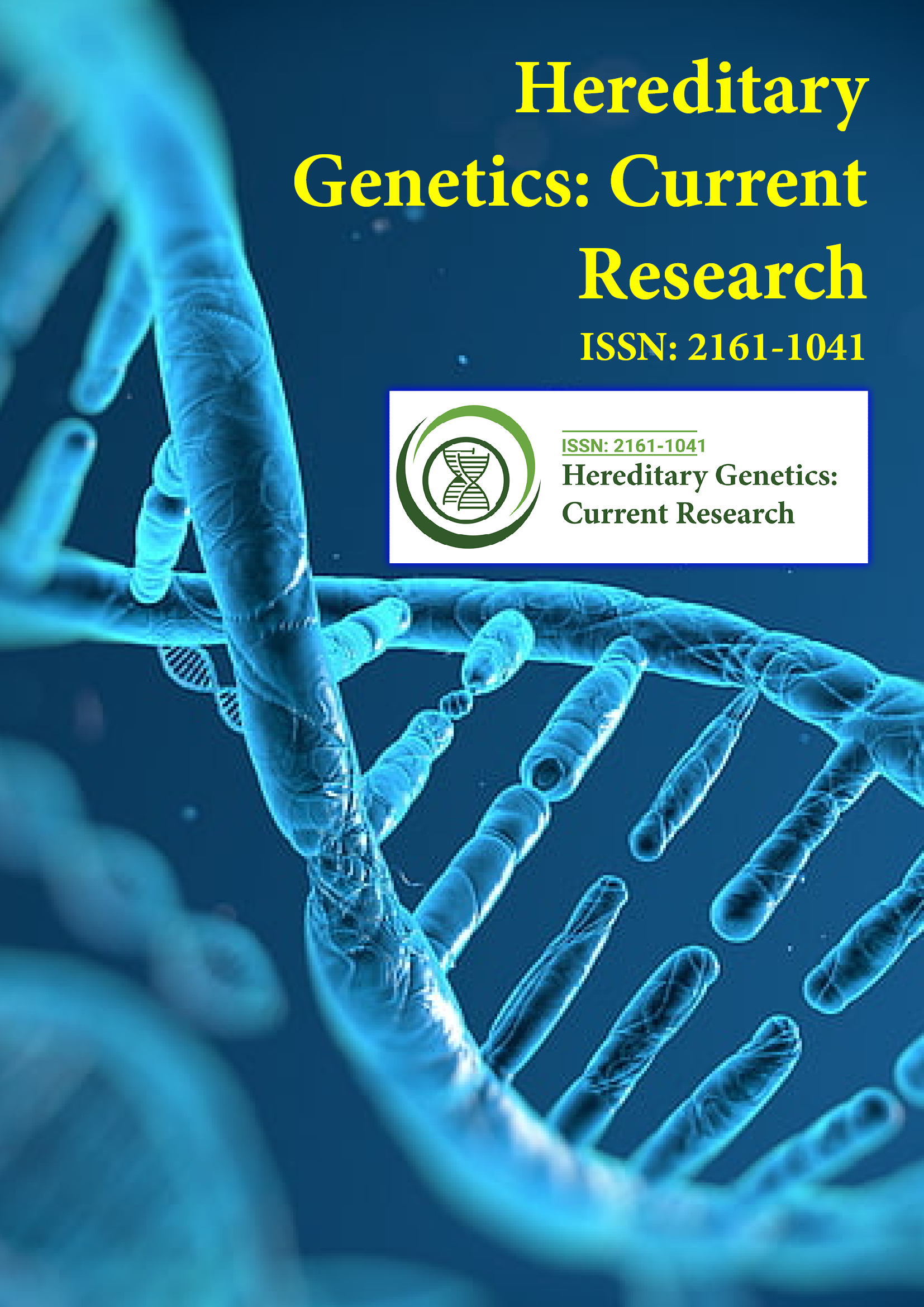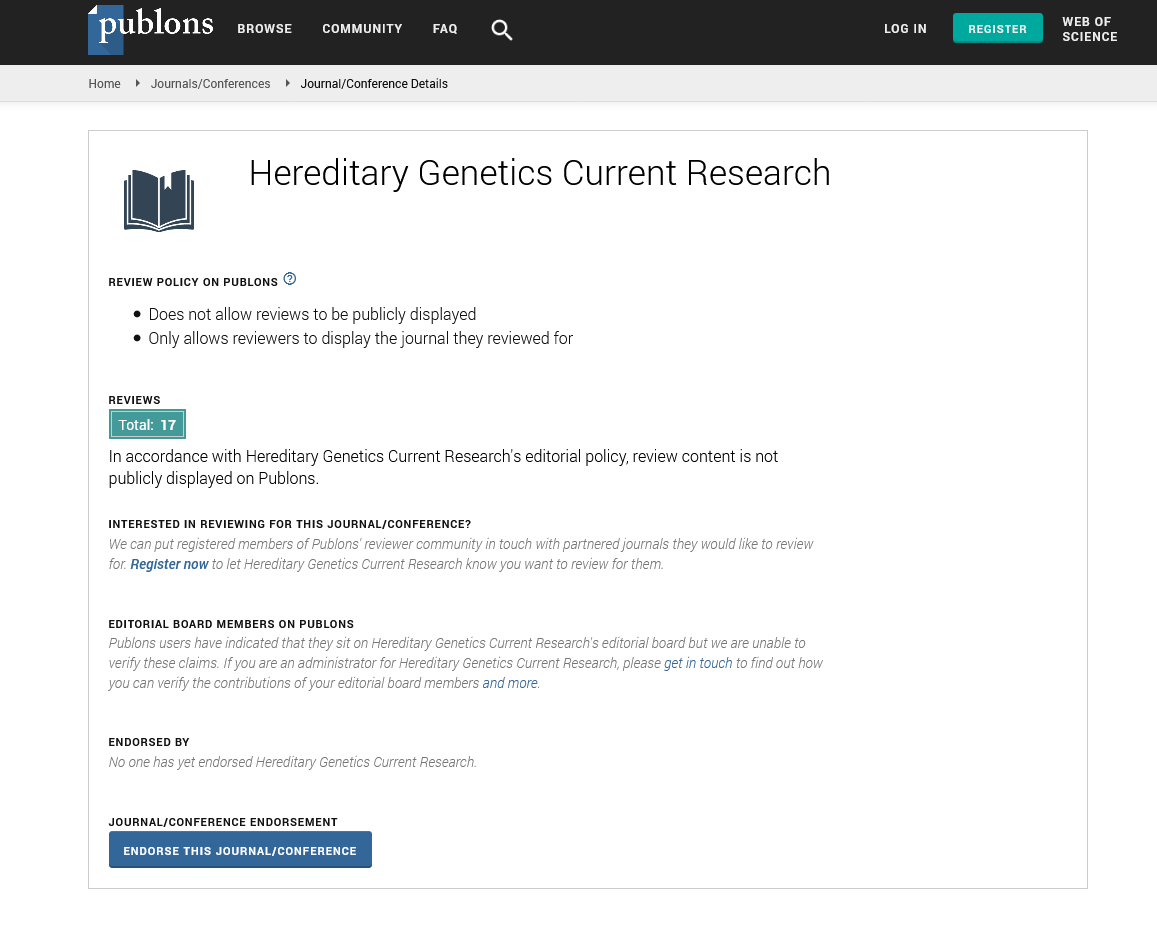PMC/PubMed Indexed Articles
Indexed In
- Open J Gate
- Genamics JournalSeek
- CiteFactor
- RefSeek
- Hamdard University
- EBSCO A-Z
- NSD - Norwegian Centre for Research Data
- OCLC- WorldCat
- Publons
- Geneva Foundation for Medical Education and Research
- Euro Pub
- Google Scholar
Useful Links
Share This Page
Journal Flyer

Open Access Journals
- Agri and Aquaculture
- Biochemistry
- Bioinformatics & Systems Biology
- Business & Management
- Chemistry
- Clinical Sciences
- Engineering
- Food & Nutrition
- General Science
- Genetics & Molecular Biology
- Immunology & Microbiology
- Medical Sciences
- Neuroscience & Psychology
- Nursing & Health Care
- Pharmaceutical Sciences
Commentary - (2023) Volume 12, Issue 3
Determining Genetic Studies of Cortical Organisation in the Brain
Miranda Smith*Received: 01-Sep-2023, Manuscript No. HGCR-23-23085; Editor assigned: 04-Sep-2023, Pre QC No. HGCR-23-23085 (PQ); Reviewed: 18-Sep-2023, QC No. HGCR-23-23085; Revised: 25-Sep-2023, Manuscript No. HGCR-23-23085 (R); Published: 02-Oct-2023, DOI: 10.35248/2161-1041.23.12.258
Description
The human brain is a complex organized organ responsible for a wide range of cognitive functions, including perception, memory, language, and decision-making. Understanding the genetic basis of cortical organization and development is a fundamental challenge in neuroscience. The human cortex, the outermost layer of the brain, is a highly convoluted structure characterized by a complex arrangement of neurons and glial cells. It plays a central role in higher-order cognitive processes and is involved in various neurological and psychiatric disorders when its organization is disrupted. The development and organization of the cortex are not only the result of genetic factors but also involve complex interactions with environmental influences. Genome-Wide Association Studies (GWAS) have emerged as a powerful tool for discovering the genetic basis of complex traits and diseases. In the context of neuroimaging phenotypes, GWAS involves the systematic examination of genetic variants across the entire genome to identify associations with specific brain features. Several large-scale GWAS have been conducted to explore the genetic contributions to various aspects of cortical organization, including surface area, thickness, and volume.
GWAS have consistently demonstrated that cortical traits, such as surface area, thickness, and volume, are heritable to varying degrees. Heritability estimates for these traits typically range from 20% to 70%, indicating that genetic factors play a substantial role in shaping individual differences in cortical structure. GWAS have identified specific genetic loci associated with cortical traits. These loci contain genes that influence various aspects of brain development and function. For example, the gene TMEM106B has been linked to cortical thickness, while the gene Cell Adhesion Molecule (CADM2) has been associated with cortical surface area. Cortical traits are often influenced by multiple genetic variants, each with a small effect size. This polygenic structure suggests that no single gene has a dominant influence on cortical organization. Instead, it is the collective action of many genes that shapes the cortical phenotype. Some genetic variants associated with cortical traits also overlap with risk factors for neuropsychiatric disorders, such as schizophrenia, bipolar disorder, and autism spectrum disorder. GWAS have provided insights into the genetic regulation of cortical development over the lifespan. They have shown that different genetic factors may influence cortical traits at different stages of development, focusing the dynamic nature of brain development. To detect genetic associations with sufficient statistical power, large sample sizes are required. Neuroimaging datasets with thousands of participants are necessary to discover delicate genetic effects on cortical organization.
Cortical traits are highly heterogeneous across individuals, and genetic associations may vary across different populations and imaging protocols. Accounting for this heterogeneity is essential to ensure the validity of findings. While GWAS can identify genetic loci associated with cortical traits, understanding the biological mechanisms underlying these associations remains a significant challenge. Most GWAS are cross-sectional, providing an enlargement of cortical organization at a single time point. These multi-omics approaches allow for a more comprehensive exploration of the molecular mechanisms underlying cortical traits. Transcriptomic data provide information about gene expression patterns in the brain. Epigenetic modifications, such as DNA methylation and histone modifications, play a vital role in gene regulation.
Integrating epigenomic data with neuroimaging can reveal how epigenetic changes influence cortical development. Studying the proteome and metabolome of the brain can offer insights into the functional consequences of genetic variations on cortical organization. These approaches provide a bridge between genetic variation and functional outcomes.
Advanced machine learning techniques, such as deep learning, can help integrate multi-omics data and identify complex relationships between genetics, epigenetics, and neuroimaging phenotypes. Understanding the functional consequences of genetic variants associated with cortical traits is critical for elucidating their roles in brain development and function. Functional Magnetic Resonance Imaging (fMRI) and other functional neuroimaging techniques can be used to assess how genetic variants influence brain connectivity and functional networks. Genetic variants associated with cortical traits can be linked to cognitive and behavioral outcomes through neuropsychological assessments and behavioral experiments. Many of the genetic variants associated with cortical traits are also associated with an increased risk of conditions like schizophrenia, bipolar disorder, and autism spectrum disorder.
Understanding the shared genetic architecture between cortical organization and these disorders could approach for more targeted interventions and treatments. Genetic markers associated with altered cortical organization could be used for risk prediction in neuropsychiatric disorders. Early identification of at-risk individuals may enable early intervention and customized treatment. The identification of specific genes and pathways involved in cortical development may inform the development of novel therapeutic targets for neuropsychiatric disorders.
Understanding the genetic basis of cortical organization can contribute to the emerging field of precision medicine, where treatment approaches are modified to an individual's genetic profile.
Conclusion
Genome-wide analyses of neuroimaging phenotypes have provided valuable insights into the genetic basis of human cortical organization and development. Challenges remain in terms of sample size, heterogeneity, and functional interpretation of findings, but ongoing advances in technology and methodology continue to direct progress in the field. Additionally, the implications of genetic insights for neuropsychiatric disorders emphasize the potential for these findings to have a transformative impact on clinical practice and drug development.
Citation: Smith M (2023) Determining Genetic Studies of Cortical Organisation in the Brain. Hereditary Genet. 12:258.
Copyright: © 2023 Smith M. This is an open-access article distributed under the terms of the Creative Commons Attribution License, which permits unrestricted use, distribution and reproduction in any medium, provided the original author and source are credited.

